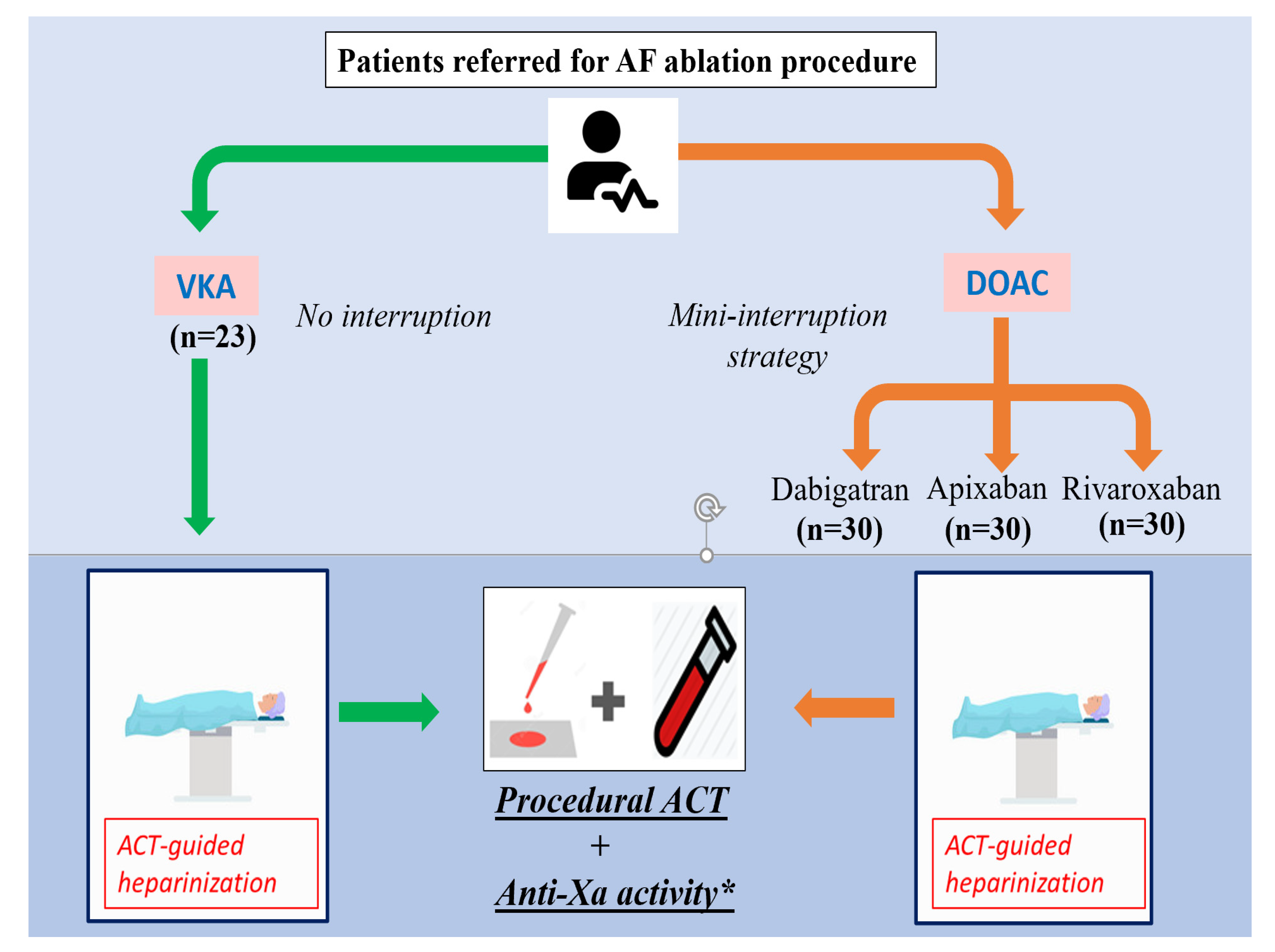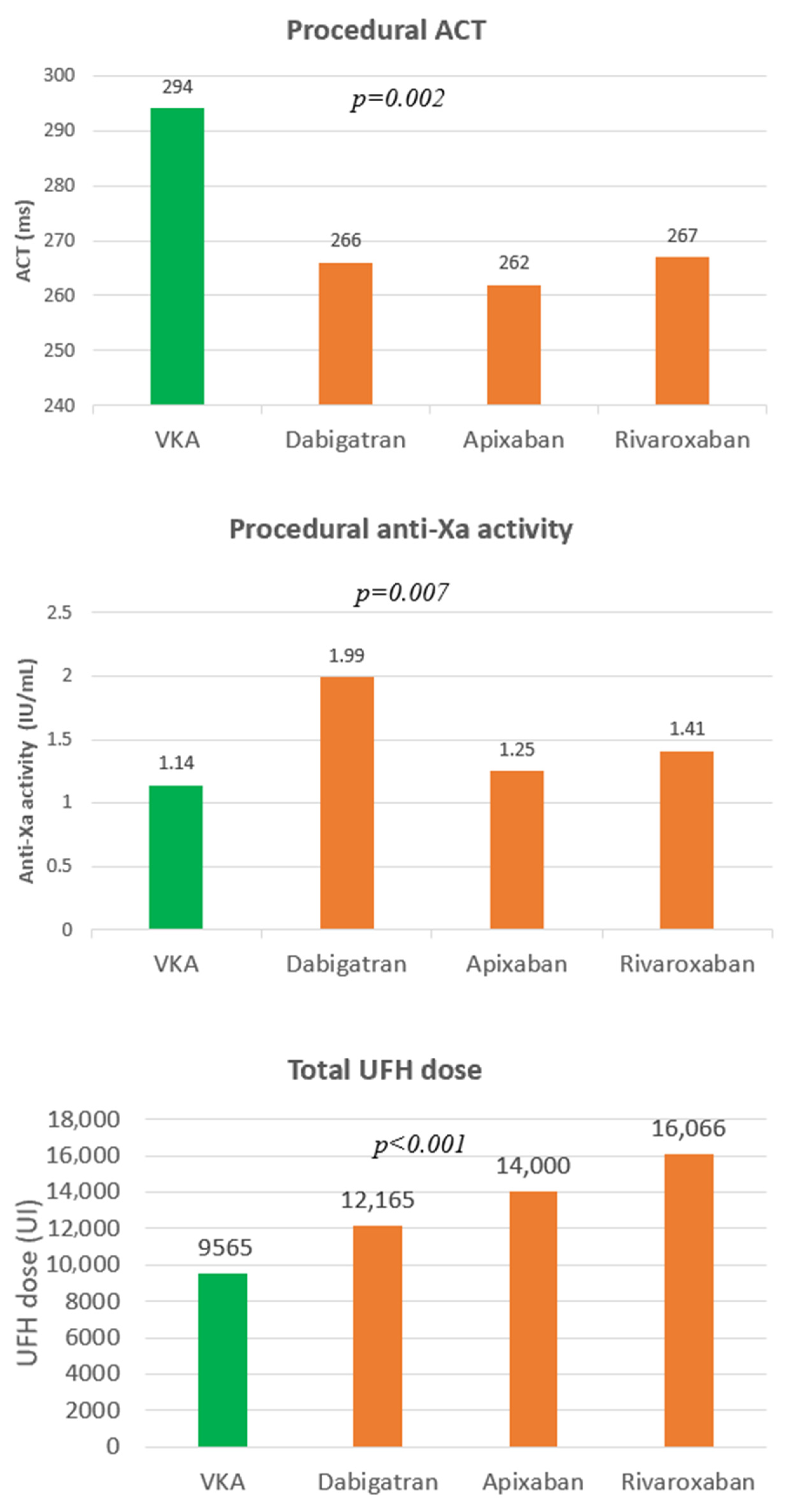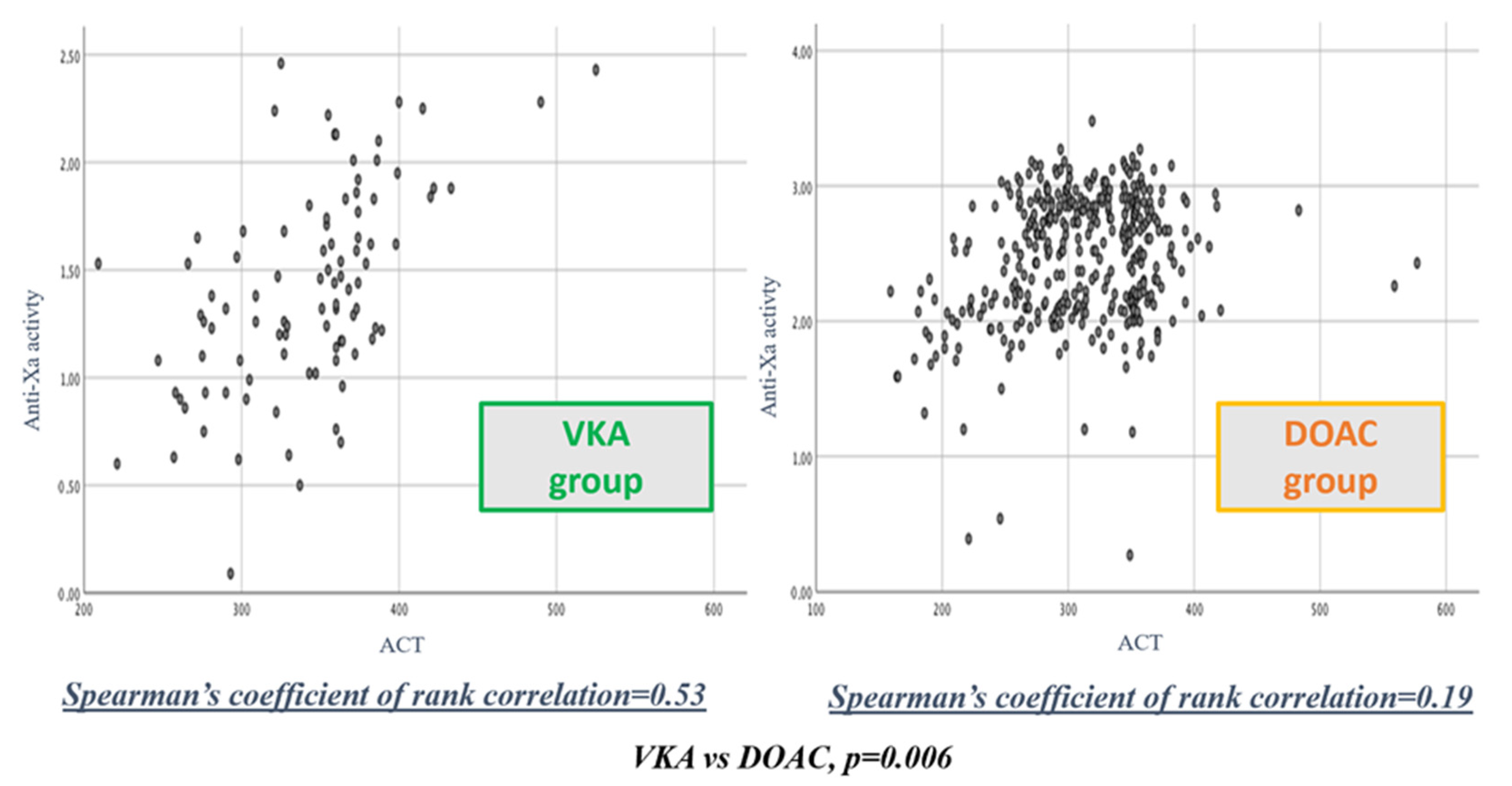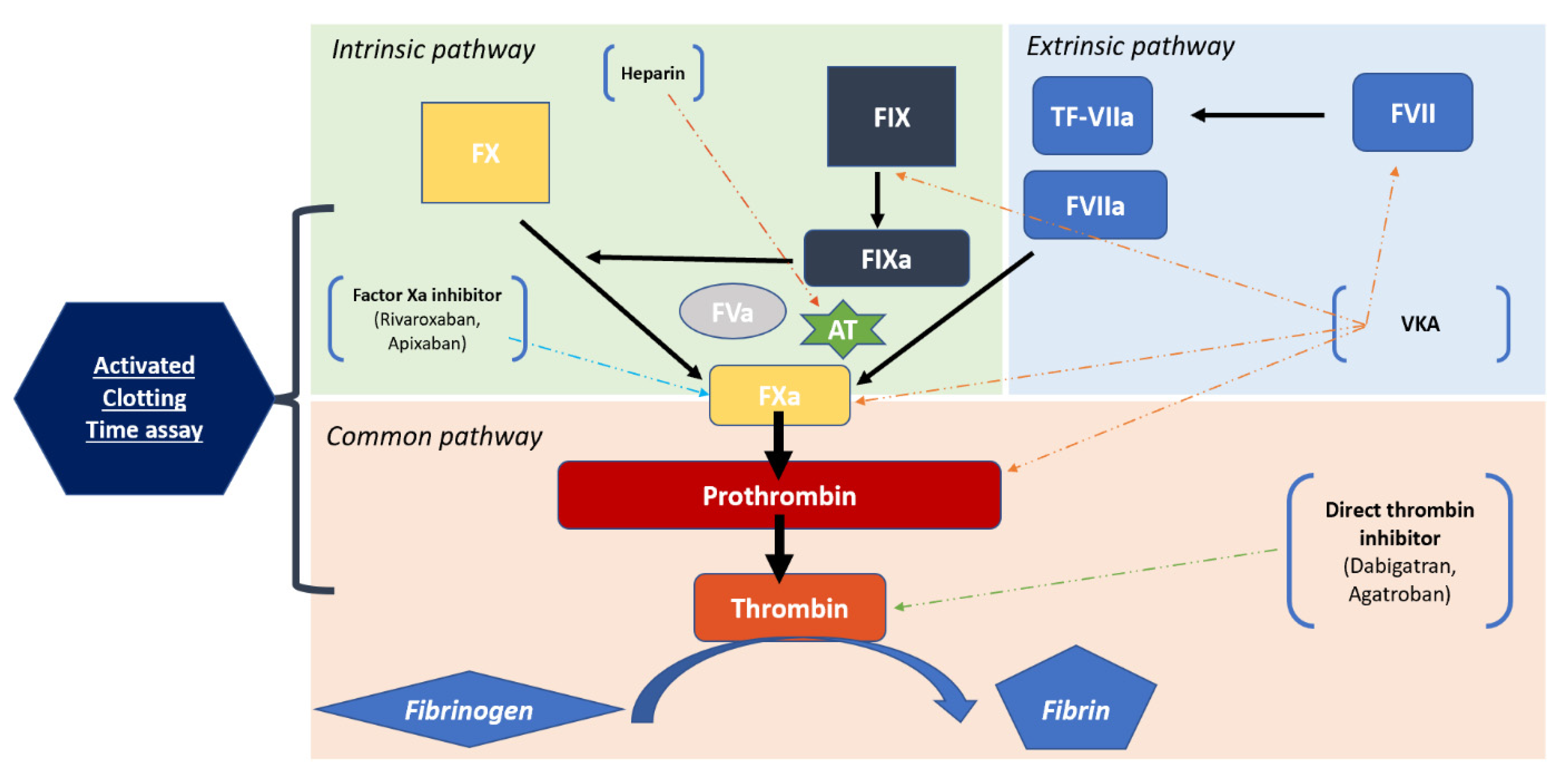Running after Activated Clotting Time Values in Patients Receiving Direct Oral Anticoagulants: A Potentially Dangerous Race. Results from a Prospective Study in Atrial Fibrillation Catheter Ablation Procedures
Abstract
1. Introduction
2. Materials and Methods
2.1. Study Design and Procedure Protocol
2.2. Study Endpoints
2.3. Statistical Analysis
3. Results
3.1. Population and Procedural Characteristics
3.2. UFH Dose, ACT, and Correlations with INR or DOAC Concentration
3.3. Correlation between ACT Values and Anti-Xa Activity
4. Discussion
4.1. Main Findings
4.2. Correlation between ACT and the Intensity of Heparin Activity
4.3. Clinical Implication
4.4. Biological Considerations and Alternatives
4.5. Study Limitations
5. Conclusions
Author Contributions
Funding
Institutional Review Board Statement
Informed Consent Statement
Data Availability Statement
Conflicts of Interest
References
- January, C.T.; Wann, L.S.; Calkins, H.; Chen, L.Y.; Cigarroa, J.E.; Cleveland, J.C., Jr.; Ellinor, P.T.; Ezekowitz, M.D.; Field, M.E.; Furie, K.L.; et al. 2019 AHA/ACC/HRS Focused Update of the 2014 AHA/ACC/HRS Guideline for the Management of Patients with Atrial Fibrillation: A Report of the American College of Cardiology/American Heart Association Task Force on Clinical Practice Guidelines and the Heart Rhythm Society in Collaboration with the Society of Thoracic Surgeons. Circulation 2019, 140, e125–e151. [Google Scholar] [CrossRef]
- Cappato, R.; Calkins, H.; Chen, S.-A.; Davies, W.; Iesaka, Y.; Kalman, J.; Kim, Y.-H.; Klein, G.; Packer, D.; Skanes, A. Worldwide Survey on the Methods, Efficacy, and Safety of Catheter Ablation for Human Atrial Fibrillation. Circulation 2005, 111, 1100–1105. [Google Scholar] [CrossRef]
- Calkins, H.; Hindricks, G.; Cappato, R.; Kim, Y.-H.; Saad, E.B.; Aguinaga, L.; Akar, J.G.; Badhwar, V.; Brugada, J.; Camm, J.; et al. 2017 HRS/EHRA/ECAS/APHRS/SOLAECE expert consensus statement on catheter and surgical ablation of atrial fibrillation. EP Eur. 2018, 20, e1–e160. [Google Scholar] [CrossRef]
- Steinbeck, G.; Sinner, M.F.; Lutz, M.; Müller-Nurasyid, M.; Kääb, S.; Reinecke, H. Incidence of complications related to catheter ablation of atrial fibrillation and atrial flutter: A nationwide in-hospital analysis of administrative data for Germany in 2014. Eur. Heart J. 2018, 39, 4020–4029. [Google Scholar] [CrossRef]
- Di Biase, L.; Burkhardt, J.D.; Santangeli, P.; Mohanty, P.; Sanchez, J.E.; Horton, R.; Gallinghouse, G.J.; Themistoclakis, S.; Rossillo, A.; Lakkireddy, D.; et al. Periprocedural Stroke and Bleeding Complications in Patients Undergoing Catheter Ablation of Atrial Fibrillation with Different Anticoagulation Management: Results from the Role of Coumadin in Preventing Thromboembolism in Atrial Fibrillation (AF) Patients Undergoing Catheter Ablation (COMPARE) Randomized Trial. Circulation 2014, 129, 2638–2644. [Google Scholar] [CrossRef]
- 2016 ESC Guidelines for the Management of Atrial Fibrillation Developed in Collaboration with EACTS. European Heart Journal; Oxford Academic. Available online: https://academic-oup-com.proxy.insermbiblio.inist.fr/eurheartj/article/37/38/2893/2334964 (accessed on 5 May 2020).
- Hohnloser, S.H.; Camm, J.; Cappato, R.; Diener, H.-C.; Heidbüchel, H.; Mont, L.; A Morillo, C.; Abozguia, K.; Grimaldi, M.; Rauer, H.; et al. Uninterrupted edoxaban vs. vitamin K antagonists for ablation of atrial fibrillation: The ELIMINATE-AF trial. Eur. Heart J. 2019, 40, 3013–3021. [Google Scholar] [CrossRef]
- Kirchhof, P.; Haeusler, K.G.; Blank, B.; De Bono, J.; Callans, D.; Elvan, A.; Fetsch, T.; Van Gelder, I.C.; Gentlesk, P.; Grimaldi, M.; et al. Apixaban in patients at risk of stroke undergoing atrial fibrillation ablation. Eur. Heart J. 2018, 39, 2942–2955. [Google Scholar] [CrossRef]
- Cappato, R.; Marchlinski, F.E.; Hohnloser, S.H.; Naccarelli, G.V.; Xiang, J.; Wilber, D.J.; Ma, C.-S.; Hess, S.; Wells, D.S.; Juang, G.; et al. Uninterrupted rivaroxaban vs. uninterrupted vitamin K antagonists for catheter ablation in non-valvular atrial fibrillation. Eur. Heart J. 2015, 36, 1805–1811. [Google Scholar] [CrossRef] [PubMed]
- Nagao, T.; Inden, Y.; Yanagisawa, S.; Kato, H.; Ishikawa, S.; Okumura, S.; Mizutani, Y.; Ito, T.; Yamamoto, T.; Yoshida, N.; et al. Differences in activated clotting time among uninterrupted anticoagulants during the periprocedural period of atrial fibrillation ablation. Heart Rhythm. 2015, 12, 1972–1978. [Google Scholar] [CrossRef]
- Konduru, S.V.; Cheema, A.A.; Jones, P.; Li, Y.; Ramza, B.; Wimmer, A.P. Differences in intraprocedural ACTs with standardized heparin dosing during catheter ablation for atrial fibrillation in patients treated with dabigatran vs. patients on uninterrupted warfarin. J. Interv. Card. Electrophysiol. 2012, 35, 277–284. [Google Scholar] [CrossRef]
- Bin Abdulhak, A.A.; Kennedy, K.F.; Gupta, S.; Giocondo, M.; Ramza, B.; Wimmer, A.P. Effect of pre-procedural interrupted apixaban on heparin anticoagulation during catheter ablation for atrial fibrillation: A prospective observational study. J. Interv. Card. Electrophysiol. 2015, 44, 91–96. [Google Scholar] [CrossRef] [PubMed]
- Zeljkovic, I.; Brusich, S.; Scherr, D.; Velagic, V.; Traykov, V.; Pernat, A.; Anic, A.; Nossan, J.S.; Jan, M.; Bakotic, Z.; et al. Differences in activated clotting time and total unfractionated heparin dose during pulmonary vein isolation in patients on different anticoagulation therapy. Clin. Cardiol. 2021, 44, 1177–1182. [Google Scholar] [CrossRef]
- Exner, T.; Rigano, J.; Favaloro, E.J. The effect of DOACs on laboratory tests and their removal by activated carbon to limit interference in functional assays. Int. J. Lab. Hematol. 2020, 42, 41–48. [Google Scholar] [CrossRef] [PubMed]
- Briceno, D.F.; Villablanca, P.A.; Lupercio, F.; Kargoli, F.; Jagannath, A.; Londono, A.; Patel, J.; Otusanya, O.; Brevik, J.; Maraboto, C.; et al. Clinical Impact of Heparin Kinetics During Catheter Ablation of Atrial Fibrillation: Meta-Analysis and Meta-Regression. J. Cardiovasc. Electrophysiol. 2016, 27, 683–693. [Google Scholar] [CrossRef] [PubMed]
- Hirsh, J.; Raschke, R. Heparin and Low-Molecular-Weight Heparin. Chest 2004, 126, 188S–203S. [Google Scholar] [CrossRef] [PubMed]
- Rosenberg, A.F.; Zumberg, M.; Taylor, L.; LeClaire, A.; Harris, N. The Use of Anti-Xa Assay to Monitor Intravenous Unfractionated Heparin Therapy. J. Pharm. Pract. 2010, 23, 210–216. [Google Scholar] [CrossRef]
- Garcia, D.A.; Baglin, T.P.; Weitz, J.I.; Samama, M.M. Parenteral Anticoagulants. Chest 2012, 141, e24S–e43S. [Google Scholar] [CrossRef]
- Martin, A.-C.; Kyheng, M.; Foissaud, V.; Duhamel, A.; Marijon, E.; Susen, S.; Godier, A. Activated Clotting Time Monitoring during Atrial Fibrillation Catheter Ablation: Does the Anticoagulant Matter? J. Clin. Med. 2020, 9, 350. [Google Scholar] [CrossRef]
- Calkins, H.; Willems, S.; Gerstenfeld, E.P.; Verma, A.; Schilling, R.; Hohnloser, S.H.; Okumura, K.; Serota, H.; Nordaby, M.; Guiver, K.; et al. Uninterrupted Dabigatran versus Warfarin for Ablation in Atrial Fibrillation. N. Engl. J. Med. 2017, 376, 1627–1636. [Google Scholar] [CrossRef]
- Frugé, K.S.; Lee, Y.R. Comparison of unfractionated heparin protocols using antifactor Xa monitoring or activated partial thrombin time monitoring. Am. J. Health-Syst. Pharm. 2015, 72 (Suppl. 2), S90–S97. [Google Scholar] [CrossRef]
- Samuel, S.; Allison, T.A.; Sharaf, S.; Yau, G.; Ranjbar, G.; McKaig, N.; Nguyen, A.; Escobar, M.; Choi, H.A. Antifactor Xa levels vs. activated partial thromboplastin time for monitoring unfractionated heparin. A pilot study. J. Clin. Pharm. Ther. 2016, 41, 499–502. [Google Scholar] [CrossRef]
- Hattersley, P.G. Activated Coagulation Time of Whole Blood. JAMA 1966, 196, 436. [Google Scholar] [CrossRef]
- Menkis, A.H.; Martin, J.; Cheng, D.C.H.; Fitzgerald, D.C.; Freedman, J.J.; Gao, C.; Koster, A.; MacKenzie, G.S.; Murphy, G.J.; Spiess, B.; et al. Drug, Devices, Technologies, and Techniques for Blood Management in Minimally Invasive and Conventional Cardiothoracic Surgery a Consensus Statement from the International Society for Minimally Invasive Cardiothoracic Surgery (ISMICS) 2011. Innovations 2012, 7, 229–241. [Google Scholar] [CrossRef]
- Despotis, G.J.; Gravlee, G.; Filos, K.; Levy, J.; Fisher, D.M. Anticoagulation Monitoring during Cardiac Surgery. Anesthesiology 1999, 91, 1122. [Google Scholar] [CrossRef]
- Dirkmann, D.; Nagy, E.; Britten, M.W.; Peters, J. Point-of-care measurement of activated clotting time for cardiac surgery as measured by the Hemochron signature elite and the Abbott i-STAT: Agreement, concordance, and clinical reliability. BMC Anesth. 2019, 19, 174. [Google Scholar] [CrossRef] [PubMed]
- Matsushita, S.; Kishida, A.; Wakamatsu, Y.; Mukaida, H.; Yokokawa, H.; Yamamoto, T.; Amano, A. Factors influencing activated clotting time following heparin administration for the initiation of cardiopulmonary bypass. Gen. Thorac. Cardiovasc. Surg. 2021, 69, 38–43. [Google Scholar] [CrossRef]
- Dincq, A.-S.; Lessire, S.; Chatelain, B.; Gourdin, M.; Dogné, J.-M.; Mullier, F.; Douxfils, J. Impact of the Direct Oral Anticoagulants on Activated Clotting Time. J. Cardiothorac. Vasc. Anesth. 2017, 31, e24–e27. [Google Scholar] [CrossRef][Green Version]
- Martin, A.-C.; Godier, A.; Narayanan, K.; Smadja, D.M.; Marijon, E. Management of Intraprocedural Anticoagulation in Patients on Non-Vitamin K Antagonist Oral Anticoagulants Undergoing Catheter Ablation for Atrial Fibrillation: Understanding the Gaps in Evidence. Circulation 2018, 138, 627–633. [Google Scholar] [CrossRef]




| Total | DOAC | VKA | |||||
|---|---|---|---|---|---|---|---|
| N = 113 | N = 90 (79.6%) | N = 23 (20.4%) | |||||
| Mean ± SD | % | Mean ± SD | % | Mean ± SD | % | ||
| Age, years | 61.4 ± 10.6 | 59.6 ± 10.8 | 68.4 ± 6.3 | ||||
| Male, sex | 71.7 | 74.4 | 60.9 | 60.9 | |||
| Weight, kg | 85.6 ± 17.6 | 86.8 ± 17.7 | 81.2 ± 17.0 | ||||
| Body mass index, kg/m2 | 28.2 ± 4.8 | 28.3 ± 4.9 | 27.8 ± 4.7 | ||||
| LVEF, % | 54.9 ± 9.0 | 54.8 ± 9.7 | 55.4 ± 5.3 | ||||
| Left atrial indexed volume, mL/m2 | 41.9 ± 20.9 | 42.0 ± 22.2 | 41.3 ± 14.9 | ||||
| CHA2DS2-VASc score, 0 to 9 | 1.7 ± 1.4 | 1.5 ± 1.4 | 2.4 ± 1.3 | ||||
| Atrial fibrillation | |||||||
| Paroxysmal | 52.2 | 51.1 | 56.5 | ||||
| Persistent | 47.8 | 48.9 | 43.5 | ||||
| Antiarrhythmic drugs | |||||||
| None | 7.1 | 8.9 | 0.0 | ||||
| Amiodarone | 30.1 | 27.8 | 39.1 | ||||
| Flecainide | 31.8 | 32.2 | 30.4 | ||||
| Beta-blockers | 65.5 | 62.2 | 78.2 | ||||
| Verapamil | 0.9 | 1.1 | 0.0 | ||||
| Digoxin | 1.8 | 1.1 | 4.3 | ||||
| Antiplatelet therapy | |||||||
| Aspirin or P2Y12 inhibitor | 4.4 | 2.2 | 13.0 | ||||
| Heart rhythm at procedure start | |||||||
| Sinus Rhythm | 59.3 | 56.7 | 69.6 | ||||
| eGFR, mL/min/1.73 m2 | 78.8 ± 13.0 | 78.5 ± 13.6 | 80.2 ± 10.4 | ||||
| Total (n = 113) | VKA (n = 23) | DOAC (90) | p-Value (VKA vs. DOAC) | ||||
|---|---|---|---|---|---|---|---|
| Total DOAC (n = 90) | Rivaroxaban (n = 30) | Apixaban (n = 30) | Dabigatran (n = 30) | ||||
| Baseline | |||||||
| -INR | 2.5 (±0.4) | ||||||
| -DOAC concentration (ng/mL) | 22.8 (±30.2) | 23.1 (±16.9) | 38.0 (±19.8) | ||||
| -ACT (s) | 157.5 (±33.4) | 186.4 (±39.8) | 150 (±27.1) | 153.8 (±34.9) | 143.7 (±22.0) | 152.8 (±22.3) | <0.001 |
| -Anti-Xa (IU/mL) (using DOAC-stop® *) | 0.52 (±0.29) | 0.13 (±0.21) | 0.62 (±0.22) | 0.47 (±0.32) * | 0.61 (±0.20) * | 0.63(±0.17) | <0.001 |
| After 1st UFH bolus | |||||||
| -ACT (s) | 271 (±45) | 294 (±42) | 265 (±44) | 267 (±41) | 262 (±36) | 267 (±54) | 0.007 |
| -anti-Xa (IU/mL) (using DOAC-stop® *) | 1.88 (±0.54) | 1.14 (±0.36) | 1.56 (±0.39) | 1.25 (±0.67) * | 1.41 (±0.7) * | 1.99 (±0.37) | 0.002 |
| -Total UFH dose (IU) | 13,159.3 (±4493.2) | 9565.2 (±3628.5) | 14,077.8 (±4237.9) | 16,066.7 (±4386.0) | 14,000 (±1556.2) | 12,166.7 (±2692) | <0.001 |
| ACT Targeting | |||||||
| -Nb UFH bolus to reach ACT > 300 s | 3.1 (±1.4) | 2.3 (±1.1) | 3.3 (±1.4) | 3.8 (±1.4) | 3.2 (±1.4) | 2.8 (±1.2) | 0.001 |
| -Time to ACT > 300 s, s (min) | 42.3 (±30.3) | 27.3 (±14.6) | 46.5 (±32.3) | 43.3 (±19.6) | 47.5 (±20.3) | 46.9 (±33.8) | <0.001 |
| -Patients with ACT > 300 s reached | 99 (87.6%) | 22 (95.7%) | 77 (85.6%) | 25 (83.3%) | 25 (83.3%) | 26 (86.6%) | <0.001 |
| -Procedure length (min) | 174.2 (±54.3) | 165.4 (±46.8) | 176.5 (±56.1) | 186 (±61.0) | 170 (±51.8) | 173 (±55.8) | 0.38 |
| Peri-procedural Complications | |||||||
| Bleeding complications | 0 (0%) | 0 (0%) | 0 (0%) | 0 (0%) | 0 (0%) | 0 (0%) | 1 |
| Thromboembolic complications | 0 (0%) | 0 (0%) | 0 (0%) | 0 (0%) | 0 (0%) | 0 (0%) | 1 |
| Spearman Correlation Coefficient | 95%CI | p-Value | |
|---|---|---|---|
| Correlation between INR/DOAC concentration and ACT values at baseline | |||
| VKA group | 0.57 | 0.46 to 0.68 | 0.004 |
| DOAC group | 0.32 | 0.15 to 0.46 | 0.021 |
| -Factor Xa inhibitors (apixaban, rivaroxaban) | 0.15 | −0.04 to 030 | 0.055 |
| -Factor IIa inhibitors (dabigatran) | 0.48 | 0.37 to 058 | 0.007 |
| Correlation between UFH dose and anti-Xa activity | |||
| VKA group | 0.73 | 0.69 to 0.77 | <0.001 |
| DOAC group | 0.71 | 0.67 to 0.75 | <0.001 |
| Correlation between procedural ACT and anti-Xa activity | |||
| VKA group | 0.53 | 0.39 to 0.67 | <0.001 |
| DOAC group | 0.19 | 0.09 to 0.30 | 0.022 |
| -Factor Xa inhibitors (apixaban, rivaroxaban) | 0.17 | 0.07 to 0.23 | 0.018 |
| -Factor IIa inhibitors (dabigatran) | 0.22 | 0.10 to 0.23 | 0.020 |
| VKA vs. DOAC | 0.006 | ||
Publisher’s Note: MDPI stays neutral with regard to jurisdictional claims in published maps and institutional affiliations. |
© 2021 by the authors. Licensee MDPI, Basel, Switzerland. This article is an open access article distributed under the terms and conditions of the Creative Commons Attribution (CC BY) license (https://creativecommons.org/licenses/by/4.0/).
Share and Cite
Benali, K.; Verain, J.; Hammache, N.; Guenancia, C.; Hooks, D.; Magnin-Poull, I.; Toussaint-Hacquard, M.; de Chillou, C.; Sellal, J.-M. Running after Activated Clotting Time Values in Patients Receiving Direct Oral Anticoagulants: A Potentially Dangerous Race. Results from a Prospective Study in Atrial Fibrillation Catheter Ablation Procedures. J. Clin. Med. 2021, 10, 4240. https://doi.org/10.3390/jcm10184240
Benali K, Verain J, Hammache N, Guenancia C, Hooks D, Magnin-Poull I, Toussaint-Hacquard M, de Chillou C, Sellal J-M. Running after Activated Clotting Time Values in Patients Receiving Direct Oral Anticoagulants: A Potentially Dangerous Race. Results from a Prospective Study in Atrial Fibrillation Catheter Ablation Procedures. Journal of Clinical Medicine. 2021; 10(18):4240. https://doi.org/10.3390/jcm10184240
Chicago/Turabian StyleBenali, Karim, Julien Verain, Nefissa Hammache, Charles Guenancia, Darren Hooks, Isabelle Magnin-Poull, Marie Toussaint-Hacquard, Christian de Chillou, and Jean-Marc Sellal. 2021. "Running after Activated Clotting Time Values in Patients Receiving Direct Oral Anticoagulants: A Potentially Dangerous Race. Results from a Prospective Study in Atrial Fibrillation Catheter Ablation Procedures" Journal of Clinical Medicine 10, no. 18: 4240. https://doi.org/10.3390/jcm10184240
APA StyleBenali, K., Verain, J., Hammache, N., Guenancia, C., Hooks, D., Magnin-Poull, I., Toussaint-Hacquard, M., de Chillou, C., & Sellal, J.-M. (2021). Running after Activated Clotting Time Values in Patients Receiving Direct Oral Anticoagulants: A Potentially Dangerous Race. Results from a Prospective Study in Atrial Fibrillation Catheter Ablation Procedures. Journal of Clinical Medicine, 10(18), 4240. https://doi.org/10.3390/jcm10184240






